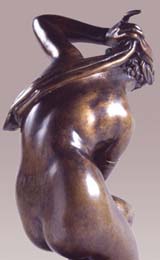Giambologna: Gods and Heroes
Genesis and Fortune of a European Style in Sculpture
This is the first exhibition that Italy dedicates to Giambologna, as well as the first after the one held in Vienna and London in 1978.
In the more than twenty years that followed, many new archive studies have been conducted, and a goodly number of scholars has most recently worked on the figure of this important artist, the most celebrated of the sculptors who lived in Italy after Michelangelo and before Bernini.
Inedited and substantial information today enables us to better comprehend his life and artistic personality.
The exhibition will concentrate on three aspects of Giambologna’s profane sculpture: models and sketches, nude figures with a mythological subject, and equestrian monuments. His “inventions” met with great success and were widely imitated at the major courts of Europe.
A section will then be devoted to the works commissioned Giambologna by Grand Duke Francesco de’ Medici, the sculptor’s most important patron.
The exhibition will present almost the entirety of the artist’s autographic works – today in museums all over the world – with a selection that privileges the highest quality of the pieces on show. Exceptional masterpieces on loan to the Bargello for this occasion include the Cesarini Venus, the bronze statues from the Kunstkammer in Vienna, the Museums of Dresden, architecture from Boston, the terracotta models from London’s Victoria and Albert Museum, etc.

The introductory essay of the catalogue will present a new monographic study on Giambologna and will be followed by scientific contributions dedicated to the most significant aspects and problems of the sculptor’s work, including his extraordinary and uninterrupted fortune among collectors.
Curated by Beatrice Paolozzi Strozzi, director of the Bargello National Museum, and Dimitrios Zikos, the exhibition will be held in the ground-floor area (recently inaugurated with the exhibition “
Bindo Altoviti, Between Raphael and Cellini”), and then continue along a Giambologna itinerary through the halls of the building, including among others, several monumental works by the sculptor such as the
Oceanus from Boboli, the
Cortesi Bacchus, the
Venus from Villa della Petraia, and
Florence Triumphs over Pisa.
The itinerary will come to an end on the second floor of the museum with its exhibition of beautiful small bronze statues of equestrian monuments, personally realised by the artist or by his direct followers, and from prestigious public and private European collections.
Beyond the walls of the Bargello, the exhibition ideally continues to many city sites which conserve famous works by this sculptor who, with his monumental creations, invented the most fascinating scenic design for Medici power.
-------------------------------------------------------
Giambologna (pseudonimo di Jean de Boulogne)
(Douai 1529 - Firenze 1608)
FJean Boulogne from Douai, Belgium, better known as Giambologna, was a driven worker, completely focused on his art and the reputation it could bring him. As Simone Fortuna wrote to the Duke of Urbino in 1581: "He is the best sort of man one could ever want to meet, not greedy at all, as one can tell from his being so poor: all that he wants is glory and his greatest ambition is to rival Michelangelo."

Despite the possibilities afforded by Giambologna's participation in Italian Renaissance court life, he was illiterate and never fully mastered the Italian language.
This immigrant became one of the most influential sculptors in Italy between 1550 and 1600. He designed elaborate fountains for the aristocratic patrons of northern and central Italy, especially for the Medici, who wanted to incorporate large sculptural projects into the landscapes of their Tuscan residences. In addition to large-scale projects, Giambologna also created smaller scale works in bronze.
His reputation among contemporaries derived in part from the wide distribution of his works through small-scale bronzes. His large workshop with its many assistants made these small bronzes and continued to reproduce them even after his death. These reproductions were so prized they were often given as diplomatic gifts to foreign envoys, ambassadors, and royalty.
------------------------------------------------------------
“Giambologna: Gods and Heroes”
Genesis and Fortune of a European Style in Sculpture
Firenze, Museo Nazionale del Bargello
via del Proconsolo 4
from March 1, 2006
until June 15, 2006


